Redistribute Questions 2
Here you will find answers to Redistribute Questions – Part 2
Question 1
Refer to the exhibit and the partial configuration on router R2. On router R4 all RIP routes are redistributed into the OSPF domain. A second redistribution is configured on router R2 using a route map. Based on the configuration on router R2, which EIGRP external routes will be present in the routing table of R1?
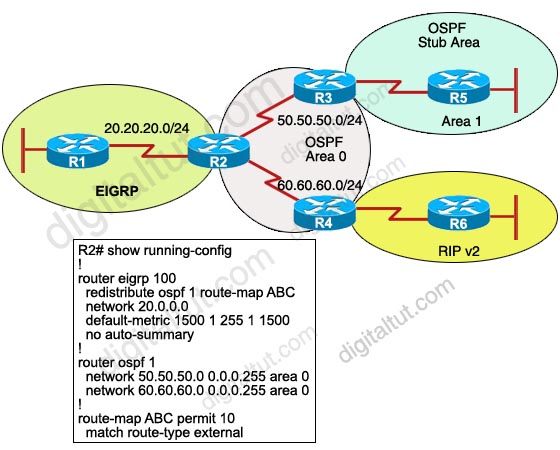
A. the routes originating from the RIP routing domain
B. the routes originating from the OSPF stub area
C. all OSPF inter and intra-area routes
D. all routes originating from RIP and OSPF routing domains
Answer: A
Explanation
R2 sees the routes from RIP domain as external routes while it sees the routes from OSPF Stub Area as internal routers. From the output we learn that the “route-type external” is redistributed from OSPF to EIGRP (via route-map ABC) so we will see the routes from the RIP domain (external) in the routing table of R1 -> A is correct.
In the case we want to redistribute routes from OSPF Stub Area (Area 1) to EIGRP we need to use the “match route-type internal” command instead.
Question 2
Refer to the exhibit. Router B is performing bidirectional redistribution between EIGRP and OSPF. The network 10.100.1.0/24 should not be reachable from the 10.100.9.0/24 network. However, it needs to be reachable from any network within the EIGRP domain. All other networks should be seen in both domains.
Which change to router B would accomplish these goals?
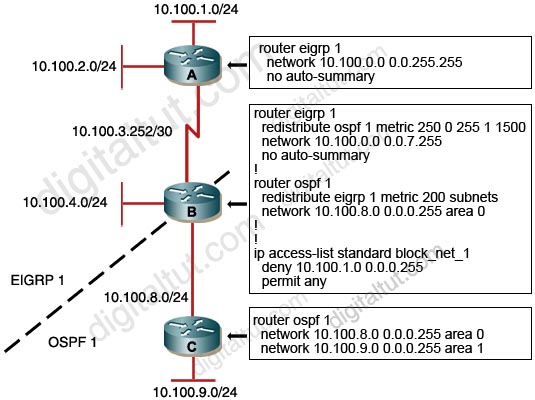
A. Under the EIGRP process, insert the distribute-list block_net_1 out ospf 1 command.
B. Under the OSPF process, insert the distribute-list block_net_1 in serial1/0 command.
C. Under the EIGRP process, insert the distribute-list block_net_1 in serial1/0 command.
D. Under the OSPF process, insert the distribute-list block_net_1 out eigrp 1 command.
Answer: D
Explanation
The network 10.100.1.0/24 should not be reachable from network 10.100.9.0/24 -> we need to filter updates from EIGRP to OSPF so that the routing table of router C doesn’t have network 10.100.1.0/24 -> we need to filter it under OSPF process and the direction should be out of router B -> D is correct.
Question 3
Which three route filtering statements are true? (Choose three)
A. After the router rip and passive-interface s0/0 commands have been issued, the s0/0 interface will not send any RIP updates, but will receive routing updates on that interface.
B. After the router eigrp 10 and passive-interface s0/0 commands have been issued, the s0/D interface will not send any EIGRP updates, but will receive routing updates on that interface
C. After the router ospf 10 and passive-interface s0/0 commands have been issued , the s0/0 interface will not send any OSPF updates, but will receive routing updates on that interface
D. When you use the passive-interface command with RIPv2, multicasts are sent out the specified interface
E. When you use the passive-interface command with EIGRP, hello messages are not sent out the specified interface
F. When you use the passive-interface command with OSPF, hello messages are not sent out the specified interface
Answer: A E F
Explanation
The “passive-interface …” command in EIGRP or OSPF will shut down the neighbor relationship of these two routers (no hello packets are exchanged) -> E, F are correct.
In RIP, this command will not allow sending multicast updates via a specific interface but will allow listening to incoming updates from other RIP speaking neighbors. This means that the router will still be able to receive updates on that passive interface and use them in its routing table -> A is correct.
Question 4
Refer to the exhibit. The routing protocols EIGRP and OSPF have been configured as indicated in the exhibit. Given the partial configuration of router R2, which network will be present in the routing table of R4?
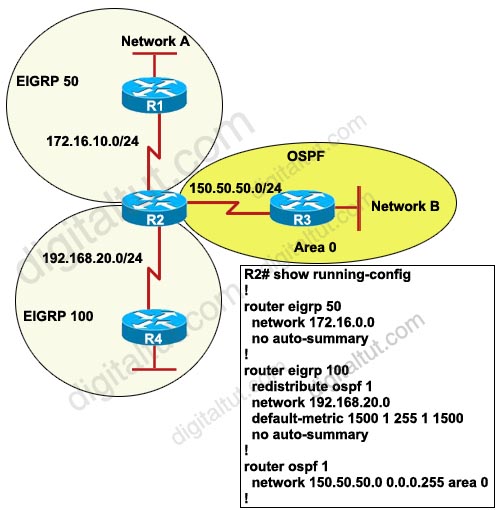
A. Network A
B. Network B
C. Network A and Network B
D. neither Network A nor Network B
Answer: B
Explanation
From the show running-config output, we learn that only OSPF is redistributed into EIGRP AS 100 so only network B will be present in the routing table of R4. Notice that we must specify the metric when redistributing into EIGRP so that it can work well.
Question 5
Refer to the exhibit. Which three statements are true? (Choose three)
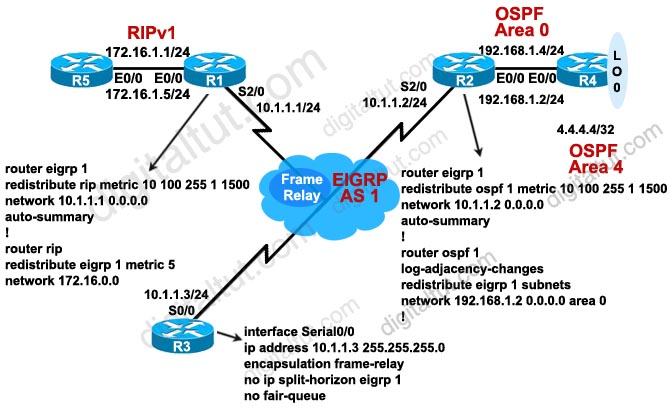
A. On the routing table of R4, the 10.1.1.0/24 route appears as an O E2 route.
B. On R4, the 172.16.1.0/24 route has a metric of 20.
C. The R3 S0/0 interface should not need the no ip split-horizon eigrp 1 configuration command for the 172.16.1.0/24 route to appear in the routing table of R2 as an D EX route.
D. The administrative distance of the 172.16.1.0/24 route in the routing table of R3 is 170.
E. On R5, the 4.0.0.0/8 route will have an administrative distance of 120 and a hop count of 6.
Answer: A B D
Explanation
When redistributing into OSPF, the default route type is E2 -> A is correct. Notice that the cost of E2 type is always the cost of external route only.
Also, the default seed metric when redistributing into OSPF is always 20 (except for BGP, which is 1) -> B is correct.
When redistributing into EIGRP, the external EIGRP routes have an administrative distance of 170 by default -> D is correct.
Question 6
Refer to the exhibit. Looking at the topology diagram and the partial router configurations shown, which statement is true?

A. A routing loop will occur due to mutual route redistribution occurring on R1 and R2.
B. Suboptimal routing will occur due to mutual route redistribution occurring on R1 and R2.
C. Additional route filtering configurations using route maps and ACLs are required on the R1 and R2 routers to prevent routing loops.
D. R2 will not be able to redistribute the EIGRP subnets into OSPF, because R2 is missing the default seed metric for OSPF.
E. The 10.1.1.0/24 subnet will appear as 10.0.0.0/8 in the R5 routing table.
Answer: E
Explanation
RIPv1 is a classful routing protocol so the subnet 10.1.1.0/24 will be summarized to 10.0.0.0/8 in the R5 routing table. If we use RIPv2 on R1, R5 and use the “no auto-summary” command on R1 then the 10.1.1.0 subnet will appear in the routing table of R5. Notice that even if the “auto-summary” command is configured under “router eigrp 1” of R1 but when redistributing into another routing protocol EIGRP still advertises the detailed network.
Question 7
Refer to the exhibit. R1 and R2 have been configured to share routing information via EIGRP. What will be the result of the configuration section shown for R2?
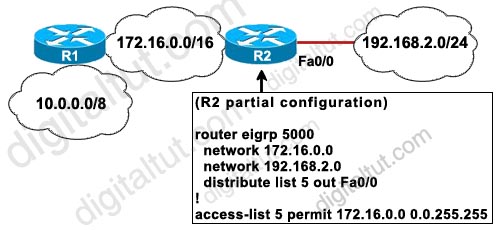
A. Any routes learned by R2 from the interface tied to the 172.16.0.0 network will not be advertised to neighbors on the 192.168.2.0 network.
B. Only routes learned by R2 from the interface tied to the 172.16.0.0 network will be advertised to neighbors on the 192.168.2.0 network.
C. Only the 172.16.0.0 network will be advertised to neighbors on the 192.168.2.0 network.
D. All networks, except the 172.16.0.0 network will be advertised to neighbors on the 192.168.2.0 network.
Answer: C
Question 8
Refer to the exhibit. EIGRP has been configured on router D. Router C is performing mutual redistribution between EIGRP and OSPF. While verifying that the redistribution is functioning properly, you discover that while router C has all of the EIGRP routes in its routing table, router A does not have any routes from the EIGRP domain. What on router C may be the cause of the problem?
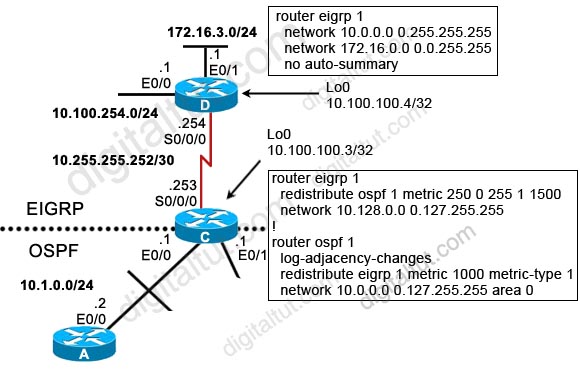
A. The no auto-summary command needs to be added under router eigrp 1.
B. The subnets keyword was not included in the redistribute command under router ospf 1.
C. The metric specified for the redistributed EIGRP routes is too large; making the EIGRP routes unreachable by router A.
D. The defauft-information originate command needs to be added under router ospf 1.
E. The administrative distance of either OSPF or EIGRP must be changed so that EIGRP has a higher administrative distance than OSPF.
Answer: B
Explanation
If we don’t use the “subnets” keyword when redistributing routes learned from another routing process into OSPF, only classful routes will be redistributed. This is an important thing to remember when redistributing into OSPF -> B is correct.
Question 9
You have implemented mutual route redistribution between OSPF and EIGRP on a border router. When checking the routing table on one of the EIGRP routers within the EIGRP routing domain, you are seeing some, but not all of the expected routes. What should you verify to troubleshoot this problem?
A. The border router is using a proper seed metric for OSPF.
B. The border router is using a proper seed metric for EIGRP.
C. The administrative distance is set for OSPF and EIGRP.
D. The missing OSPF routes are present in the routing table of the border router.
E. The subnet keyword on the border router in the redistribute OSPF command.
Answer: D
Explanation
We are checking the routing table on EIGRP routers not OSPF so we don’t need to check the seed metric for OSPF. Besides OSPF doesn’t need to specify seed metric as all external routes get a default metric of 20 (except for BGP, which is 1) -> A is not correct.
We must specify seed metrics when redistributing into EIGRP (and RIP). If not all the redistributed routes will not be seen but the question says only some routes are missing -> B is not correct.
The default administrative distance for external routes redistributed into EIGRP is 170 so we don’t need to set it -> C is not correct.
The sunbet keyword is only used when redistributing into OSPF, not to other routing protocols -> E is not correct.
We should check the routing table of the border router to see the missing OSPF routes are there or not. An incorrect distribute-list can block some routes and we can’t see it in other EIGRP routers -> D is correct.
Question 10
Refer to the exhibit. Which two statements are correct regarding the routes to be redistributed into OSPF? (Choose two)
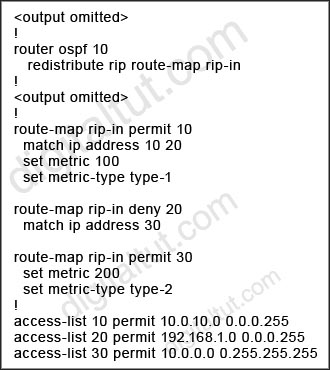
A. The network 192.168.1.0 will be allowed and assigned a metric of 100.
B. The network 192.168.1.0 will be allowed and assigned a metric of 200.
C. All networks except 10.0.0.0/8 will be allowed and assigned a metric of 200.
D. The network 172.16.0.0/16 will be allowed and assigned a metric of 200.
E. The network 10.0.10.0/24 will be allowed and assigned a metric of 200.
Answer: A D
Explanation
These rules apply when using route-map with an access-list:
* If you use an ACL in a route-map permit clause, routes that are permitted by the ACL are redistributed.
* If you use an ACL in a route-map deny clause, routes that are permitted by the ACL are not redistributed.
* If you use an ACL in a route-map permit or deny clause, and the ACL denies a route, then the route-map clause match is not found and the next route-map clause is evaluated.
And in each route-map:
* Multiple match criteria in the same line use a logical OR
* Each vertical match uses a logical AND
Therefore in this question, the networks in the access lists 10 and 20 (10.0.10.0/24 & 192.168.1.0/24) will be permitted while the network in access list 30 (10.0.0.0/8) will be denied.
Notice that there is no “match” line in the clause 30 so all networks that are not matched with clause 10 & 20 will be matched in the clause 30 and will be set a metric of 200, type 2 -> answer D is correct.
In this question please don’t be confused between the route-map clause number (sequence number) and the access-list number. The “match ip address” specifies which access lists are matched. The route-map clause number only uses to specify the order in which the clauses are executed.



Great place to order cheap personalized jerseys by
Paypal. marlon brown
Who do you want to gift for cheap Melvin Gordon jerseys?
Get value into the page: 44 Elite Texans Houston Texans Women Jersey Stitched Nike NFL 10th Navy Blue Team
Color
cheap new jerseys Amazon Shopper online retail,with link:
nfl cleveland indians jerseys coupons
What is size of wholesale Bennie Logan jerseys may have?
Know more about here – cheap authentic nfl jerseys free
shipping